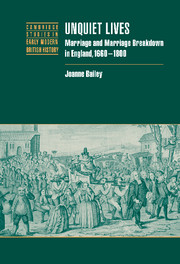Book contents
- Frontmatter
- Contents
- Acknowledgements
- List of abbreviations and conventions
- 1 Introduction: reassessing marriage
- 2 ‘To have and to hold’: analysing married life
- 3 ‘For better, for worse’: resolving marital difficulties
- 4 ‘An honourable estate’: marital roles in the household
- 5 ‘With all my worldly goods I thee endow’: spouses' contributions and possessions within marriage
- 6 ‘Wilt thou obey him, and serve him’: the marital power balance
- 7 ‘Forsaking all other’: marital chastity
- 8 ‘Till death us do part’: life after a failed marriage
- 9 ‘Mutual society, help and comfort’: conclusion
- Appendices
- Bibliography
- Index
- Titles in the series
7 - ‘Forsaking all other’: marital chastity
Published online by Cambridge University Press: 27 July 2009
- Frontmatter
- Contents
- Acknowledgements
- List of abbreviations and conventions
- 1 Introduction: reassessing marriage
- 2 ‘To have and to hold’: analysing married life
- 3 ‘For better, for worse’: resolving marital difficulties
- 4 ‘An honourable estate’: marital roles in the household
- 5 ‘With all my worldly goods I thee endow’: spouses' contributions and possessions within marriage
- 6 ‘Wilt thou obey him, and serve him’: the marital power balance
- 7 ‘Forsaking all other’: marital chastity
- 8 ‘Till death us do part’: life after a failed marriage
- 9 ‘Mutual society, help and comfort’: conclusion
- Appendices
- Bibliography
- Index
- Titles in the series
Summary
CHANGING UNDERSTANDINGS OF ADULTERY
It is well known that a sexual double-standard was rooted in English law and institutions. It was apparent in, amongst other things, conduct books, the law relating to divorce with remarriage and the suing of defamation cases for sexual slander. In them women's pre-marital and extra-marital sex would appear to be punished far more harshly than men's and carried far greater social consequences. However, it is dangerous to presume that this sexual double-standard was so pervasive that the demand for female chastity wholly determined married women's lives and shaped married men's through the fear of cuckoldry, while, conversely, wives tolerated and even ignored male adultery. This is particularly so in the long eighteenth century when definitions of adultery and assessments of culpability were remodelled and complicated by a variety of social and gender shifts. For one thing, the regulation of sexual immorality was changing. Individuals were increasingly unlikely to be prosecuted for the crime of adultery. After the Restoration the volume of cases correcting fornication and adultery in the ecclesiastical courts decreased. There is still evidence that while individuals were prepared to ignore formal action against them, they were not always successful in evading punishment. In 1684 William Addison, a yeoman, petitioned the Bishop of Durham and justices of the peace to intervene in a correction case he had promoted against the gentleman Thomas Ashmall. Thomas was living in adultery with his maid, who was also William's daughter, Mary Addison.
- Type
- Chapter
- Information
- Unquiet LivesMarriage and Marriage Breakdown in England, 1660–1800, pp. 140 - 167Publisher: Cambridge University PressPrint publication year: 2003



